When you’re planning a bathroom remodel, one of the most fun decisions you’ll make is choosing the perfect shower. But with so many options—from walk-in showers with slick glass enclosures to luxurious steam showers—it can feel overwhelming. What kind of shower fits your lifestyle? How much space do you need? What features are worth the investment?
In this guide, we’ll walk you through everything you need to know to create a shower that’s not only functional but also your happy place.
What are the most common types of showers?
When it comes to showers, there are several popular options, each with its own pros and cons:
Walk-in showers
Walk-in showers have no doors or curtains, perfect for minimalistic, modern bathrooms. They feel roomy and are easy to clean, so they’re great for those who value simplicity and style.
Frameless glass showers
Frameless glass showers are elegant, showcasing beautiful tile work and brightening up the space. Their sleek, unobstructed design is a great aesthetic, but they require regular cleaning to stay spotless.
Tub-shower combos
A tub-shower combo is the ultimate in versatility, giving you both the option of a quick rinse and a soak. Perfect for families and those who like flexibility, they combine functionality with a classic look.
Corner showers
Great for small spaces, corner showers allow you to maximize the footprint of your bathroom. Modern finishes and space-efficient corner shower designs balance practicality with a little luxury.
Steam showers
Steam showers take your daily routine to the next level with spa-like relaxation! They can even offer health benefits like improved circulation and respiratory relief! While they’re a bigger investment, they’re perfect for those who want wellness and indulgence.
How do I determine the right shower size for my bathroom?
Before you fall in love with a specific shower style, you need to make sure it fits your bathroom’s layout and your lifestyle. Here’s how to do that:
Measure your space
Start by measuring the length, width and height of your bathroom. Take note of where the toilet, vanity and bathtub are located, as these will impact your shower space. Don’t forget to account for doors, windows and plumbing lines that will affect your design.
While you may be dreaming of a luxurious shower, you still need to stay practical. Building codes usually require a minimum of 30 x 30 for a shower, but going bigger—36 x 36 or 60 for a walk-in shower—can be so much more comfortable. Larger spaces mean easier movement, so your shower will be more enjoyable to use.
Accessibility
If you’re designing for future needs or mobility issues, a bigger, curbless shower is often a good idea. A shower with enough space for a built-in bench, grab bars or even a handheld showerhead can make all the difference in comfort and safety. This is especially important for aging in place or multi-generational homes.
By thinking through these factors, you’ll create a shower space that’s as functional as it is beautiful, tailored to your bathroom’s unique needs.
How do I plan the shower layout?
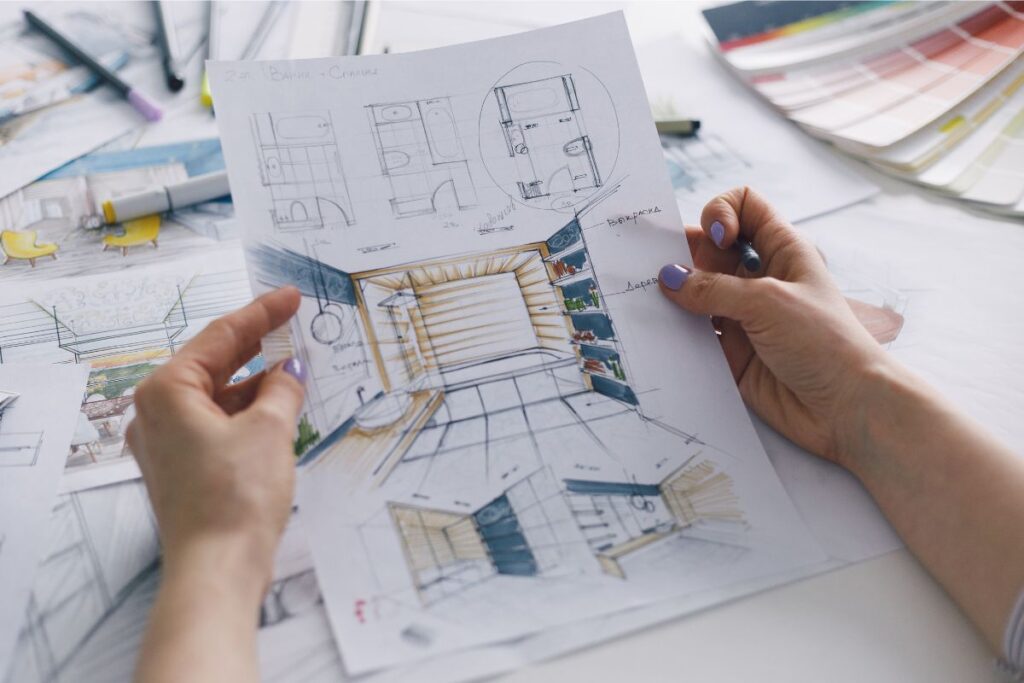
A well-thought-out shower layout means your bathroom is both functional and gorgeous. By focusing on key design elements, you can create a shower space that fits your lifestyle while enhancing your bathroom’s overall aesthetic. Here are some tips to help you plan:
Prioritize plumbing
Keep the shower near existing plumbing fixtures to save costs and simplify the remodel. Working within your bathroom’s existing layout avoids major changes, allowing small placement tweaks that create visual impact without added expense.
Consider sightlines
Since the shower is often the bathroom’s focal point, position it to enhance visual flow. A frameless glass shower can showcase tile work and open up the space. Avoid placements that block sightlines or feel cramped; instead, make your shower the design centerpiece.
Plan for storage
Built-in storage like niches and shelves keeps your shower organized and clutter-free. Position these at eye level for easy access or along a feature wall for added interest. Shelves or corner caddies can be practical without sacrificing style.
By thinking through these elements, you can design a shower layout that balances functionality, aesthetics, and convenience. Work with your contractor to bring your vision to life while addressing practical considerations like plumbing and structural requirements.
What materials are best for shower walls and floors?
Choosing the right materials for your shower walls and floors is key to getting the style, functionality and maintenance you want. Let’s break it down into two categories:
Shower Walls
Tile: A classic and versatile choice, tile comes in a wide range of colors, patterns and textures. Porcelain and ceramic tiles are durable and easy to clean, perfect for daily use. For those who want to add a touch of luxury, natural stone options like marble or travertine are elegant but require regular sealing and more maintenance to keep them looking beautiful.
Acrylic panels: If you’re looking for a budget-friendly and low-maintenance option, acrylic panels are worth considering. Their seamless design minimizes grout lines, making them easy to clean and offer a sleek modern look. Perfect for homeowners who want a hassle-free solution.
Solid surface: Made from a blend of resin and natural materials, solid surface walls are non-porous and highly durable. They provide a clean uniform look and come in various colors and patterns. Solid surface walls are a great choice for those who want an easy-to-maintain yet stylish shower.
Glass: Glass walls or enclosures give your shower a sleek contemporary look. Frosted or textured glass provides privacy while still allowing light to pass through, creating a bright and airy space. While visually stunning, glass walls do require regular cleaning to prevent water spots and soap scum buildup.
Shower Floors
Tile: Tile is popular for shower floors due to its versatility and visual appeal. Mosaic tiles are especially loved for their slip resistance and ability to create intricate designs. However, grout lines will need regular cleaning to keep them looking fresh.
Pebble or textured floors: For a natural and earthy feel, pebble or textured floors are a great choice. They’re visually striking and slip-resistant. Just keep in mind that their uneven surface may require more effort to clean.
Acrylic shower pans: Lightweight and affordable, acrylic shower pans are a practical option for budget-conscious homeowners. They’re easy to install and maintain, making them a popular choice for quick updates or remodels.
Solid surface pans: These pans offer a sleek cohesive look when paired with solid surface walls. Their non-porous nature makes them resistant to mold and mildew, and they’re very durable, providing a long-lasting and low-maintenance solution for your shower floor.
How much does a shower replacement cost?
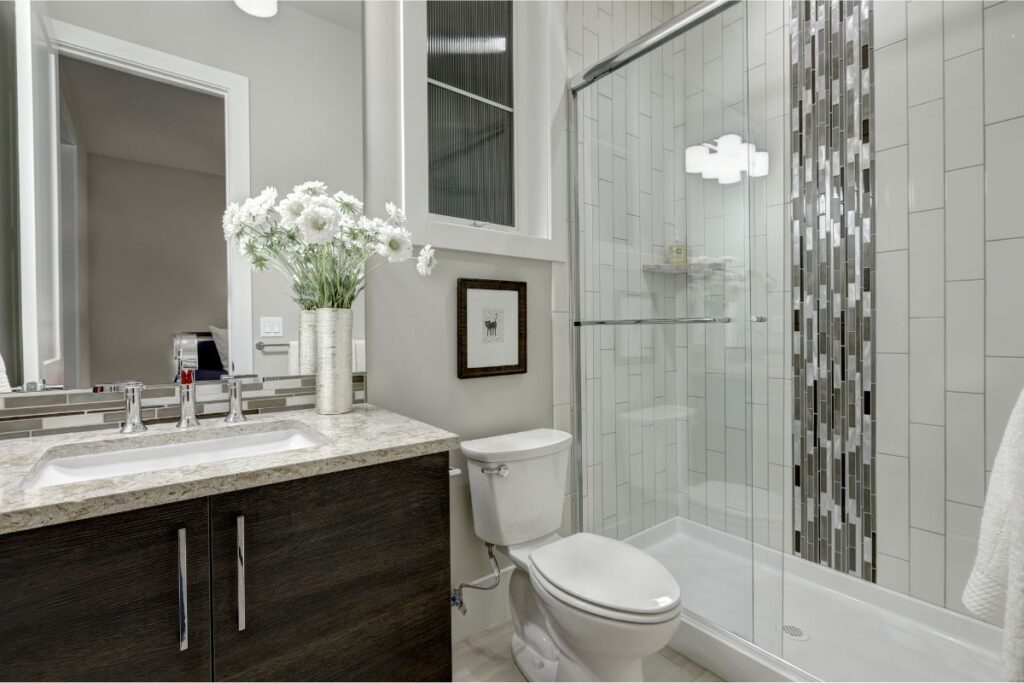
The cost of a shower remodel can vary greatly depending on your location, type of shower, materials used, and scope of the project. Here’s a breakdown to give you an idea of what to expect to pay for a shower in the New Hampshire seacoast in 2025:
Acrylic Showers
Acrylic shower units are the most budget-friendly option. They’re pre-fabricated and easy to install, which keeps labor costs low. Homeowners can expect to pay between $12,000 and $15,000 for a professionally installed acrylic shower, including necessary plumbing and drywall adjustments.
Solid Surface Showers
For a step up in durability and style, solid surface showers offer a sleek and seamless look. These showers are made from a blend of resin and natural materials, providing a non-porous and low-maintenance surface. The cost for a solid surface shower ranges from $15,000 to $20,000+, depending on design and customizations.
Tile Showers
Tile showers offer the ultimate in customization and luxury, with endless design options. From intricate mosaics to large-format porcelain tiles, the cost of a tile shower varies based on materials and the complexity of the design. On average, a professionally installed tile shower costs between $18,000 and $30,000+. Keep in mind tile showers require more labor for precise installation and grout sealing.
What other costs should I consider in a shower remodel?
Whether your shower remodel is part of a full bathroom renovation or a standalone project, there are other costs to factor in that can impact your overall budget and timeline:
Drywall repair and painting
Removing an old shower often requires cutting into the surrounding drywall. Once the new shower is installed, this drywall will need to be patched and painted to make it look smooth and professional.
Flooring adjustments
Shower pans rarely fit perfectly into the old unit’s footprint, so you may need to modify or fill in sections of flooring. In older bathrooms, you may even need to replace the entire floor for a cohesive look.
Plumbing updates
New shower designs often require changes to plumbing lines. This could mean moving the showerhead, adding body sprays or upgrading to a thermostatic valve, all of which can add to the cost. Proper plumbing ensures good water flow and function.
Permits
Depending on your location and scope of project, permits may be required for plumbing or structural changes. Permits ensure all work meets building codes and safety standards, protecting your investment and avoiding legal issues.
By factoring these costs in upfront, you’ll avoid surprises and keep your shower remodel on track and on budget.
How do acrylic, solid-surface, and tile showers compare?
Choosing between acrylic, solid-surface, and tile showers depends on your budget, maintenance preferences, and design goals. Here’s a comparison to help you decide:
Acrylic Showers
Acrylic showers are a budget-friendly option, perfect for homeowners looking for a quick and easy upgrade. They’re lightweight, easy to install, and require little maintenance. However, customization options are limited and they won’t give you the high-end look of other materials. Acrylic is durable but can scratch or dull over time if it isn’t well maintained.
Solid-Surface Showers
Solid-surface showers are a mid-range option that balances affordability and luxury. Made from a blend of resin and natural materials, these showers are durable, non-porous, and easy to clean. They come in a range of colors and patterns, offering more customization than acrylic but less than tile. Solid-surface showers offer a sleek seamless look, perfect for those who want a modern look with low maintenance.
Tile Showers
Tile showers are the ultimate in customization and luxury. They allow endless design options, from intricate mosaics to bold statement tiles. Porcelain, ceramic, and natural stone options cater to different styles and budgets. While tile showers require more maintenance—mainly grout cleaning—newer premium grouts reduce the frequency of upkeep. Tile showers are durable and luxurious, making them a popular choice for high-end remodels.
Should I go with a curbless shower design?
Curbless, or barrier-free, showers have become very popular and it’s easy to see why. They offer more than just a modern look—they’re practical, accessible, and low maintenance. Let’s explore the reasons why a curbless shower might be the best choice for you:
Accessibility
Curbless showers offer unmatched ease of access, perfect for those with mobility issues, whether due to age, injury, or disability. They accommodate mobility aids like wheelchairs and walkers with ease. Planning for aging in place? A curbless shower is a future-proof, practical choice.
Modern look
These showers provide a seamless, open look that increases bathroom flow and makes the space feel larger. The lack of a curb complements modern styles and pairs well with frameless glass, sleek tile, or natural stone for a spa-like atmosphere.
Low maintenance
With fewer crevices to trap dirt, curbless showers are easy to clean. No more scrubbing grout lines along a curb—a quick wipe-down keeps everything spotless and fresh, making them a low-maintenance favorite.
Drainage
From a construction perspective, curbless showers pose some unique challenges. Proper planning is crucial, as it ensures proper drainage for curbless showers. By working with an experienced contractor who knows the unique requirements of curbless showers you can enjoy all the benefits of this stylish and practical design without any headaches down the road.
What kind of showerheads should I choose?
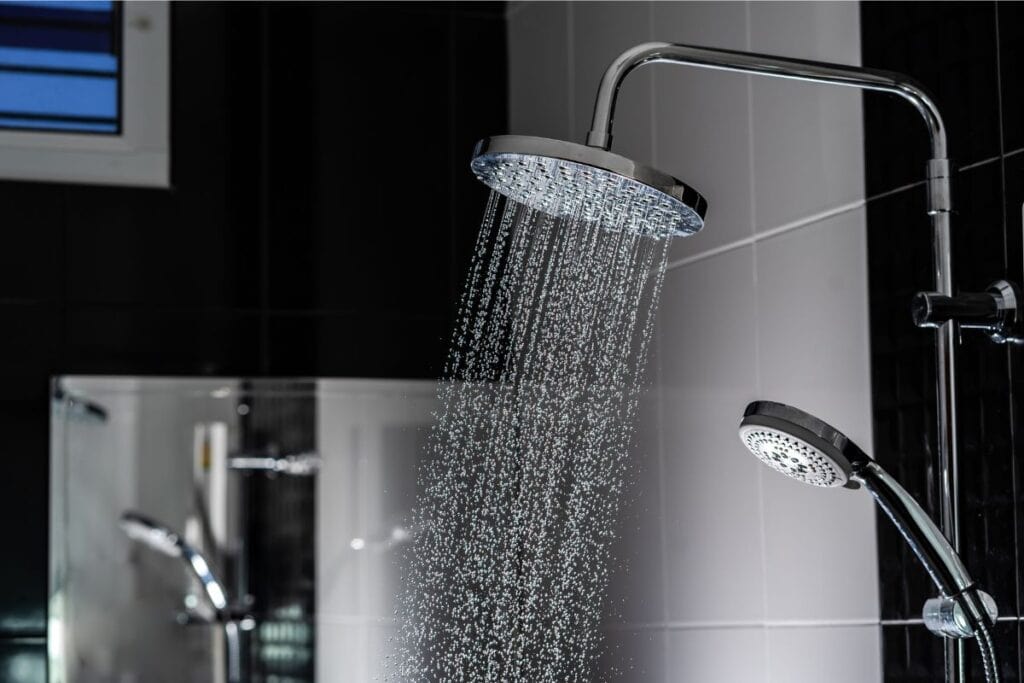
The showerhead you choose can make or break your daily routine and overall shower experience. Whether you want relaxation, versatility, or a spa-like retreat, there’s a showerhead for you. Let’s explore some of the best options:
Rain showerheads
Rain showerheads offer a gentle flow that mimics natural rainfall, a calming and luxurious experience. Mounted on the ceiling or high on the wall, they work best in showers with plenty of space and strong water pressure. They bring the spa experience to your bathroom, making them perfect for long showers.
Handheld showerheads
Versatile and practical, handheld showerheads attach to a flexible hose, letting you direct water where you need it. They’re great for rinsing hard-to-reach areas, cleaning the shower, or washing pets. Many models include adjustable spray settings, from gentle mist to powerful jet, for your personal shower experience.
Wall-mounted showerheads
Wall-mounted showerheads are a classic, budget-friendly option with consistent performance. Available in many styles and finishes, many models feature adjustable angles for customized comfort, making them a reliable choice for any bathroom design.
Body sprays
Body sprays offer a spa-like experience by spraying water at various points, enveloping you in a soothing cascade. Mounted on shower walls, they provide targeted therapeutic benefits like muscle relaxation and add a touch of luxury to your daily routine.
Dual showerheads
Combining a rain showerhead with a handheld, dual showerheads offer maximum flexibility. Switch between a gentle overhead flow and a targeted spray, perfect for shared bathrooms or anyone who wants variety and convenience in their shower.
By considering your needs you can choose a showerhead that enhances your daily routine and turns your shower into a personal oasis.
How do I choose the right water pressure and flow rate?
Water pressure is a key to a satisfying shower experience. Whether you prefer a gentle mist or a powerful stream, understanding water pressure and flow rate will help you choose the right setup for you. Here’s what to consider:
Flow rate
Flow rate measures how much water flows from your showerhead in gallons per minute (GPM). Higher flow rates provide stronger water pressure for a more intense shower, but many regions cap flow rates at 2.5 GPM to conserve water. Low-flow showerheads are a great option for an eco-friendly, yet satisfying, experience
Showerhead type
Different showerheads offer varying levels of water pressure optimization. “High-efficiency” or “pressure-boosting” models enhance flow even at lower GPM rates. Features like aerated or laminar flow technology also improve the sensation of pressure without increasing water consumption.
Check your home’s water pressure
Residential water pressure typically ranges from 40 to 60 PSI (pounds per square inch). If yours is below this, showers may feel underwhelming. Use a pressure gauge to test it, and if necessary, consider making plumbing adjustments, using a pressure-boosting showerhead, or installing a water pressure booster pump to increase flow.
By considering these factors you can ensure your shower delivers the perfect balance of pressure and flow and turns your daily routine into a truly refreshing experience.
Should I get a stand-alone diverter or a shower valve with an integrated diverter?
When planning your shower’s functionality the diverter is an important component that determines how water flows between different outlets. Choosing the right diverter depends on your layout, design goals, and personal preferences. Here’s a closer look at the two main options:
Stand-alone diverter
A standalone diverter provides maximum flexibility, allowing you to switch between multiple water sources like a rain showerhead, handheld showerhead, and body sprays. Each water source has its own control, so you can adjust the water flow exactly how you want it. This is ideal for:
- Complex shower setups: If your dream shower includes multiple water features, a standalone diverter gives you control over each one.
- Customizable experiences: You can control water pressure and flow for each outlet.
But there are a few considerations:
- Space requirements: Standalone diverters require separate controls which take up more wall space.
- Installation complexity: Adding more controls increases installation time and cost.
Shower valve with integrated diverter
An integrated diverter combines water temperature control and outlet switching into one unit. This streamlined design simplifies the user experience and reduces the number of controls on the shower wall. It’s great for:
- Small showers: In compact spaces, wall clutter is key.
- Minimalist aesthetic: The all-in-one design creates a clean modern look.
While integrated diverters are convenient and space-saving, they may not offer as much flexibility in controlling multiple water features as standalone diverters.
Which one is right for you?
Your choice will largely depend on your shower layout and how you plan to use it. For a spacious shower with more than 2 or 3 features, a standalone diverter is the way to go. If you prefer a minimalist design or limited space, an integrated diverter is the way to go. Talk to your contractor to ensure your shower setup fits your needs.
What are the must-haves for a luxurious shower?
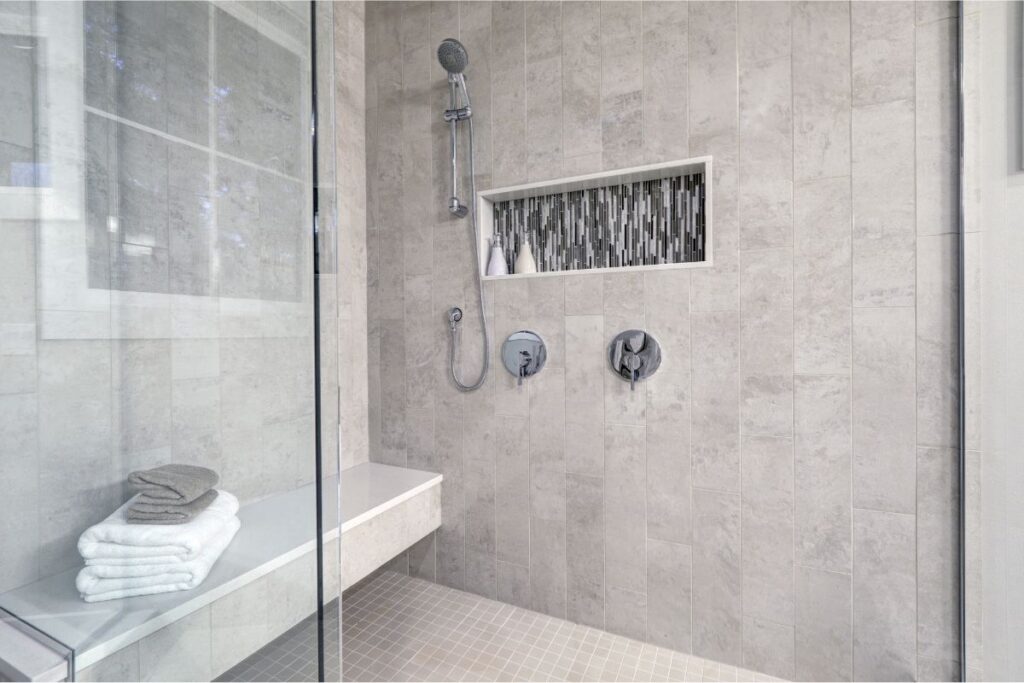
If you want to turn your bathroom into a spa-like retreat, incorporate luxurious features into your shower design. These thoughtful additions will elevate your daily routine and turn your shower into a personal oasis. Here are the must-haves:
Built-in niches
Say goodbye to cluttered shower floors! With built-in niches, you’ll have a sleek and practical storage solution for shampoo, soap, and essentials. Customizable in size and placement, niches blend in with your shower design. Add accent tiles or lighting for extra luxury.
Benches or seats
A bench adds comfort and practicality. Whether for shaving, relaxing, or storing items, it adds accessibility to your shower. Choose between tile, stone slabs, or solid surface panels to match your shower walls and elevate the design.
LED lighting
LED lighting changes your shower ambiance from soft warm glows to vibrant colors. Waterproof LED strips along ceilings, walls, or niches add visual drama, setting the mood for relaxation or energy.
Smart controls
Smart controls let you fine-tune water temperature, flow, and spray patterns. Save your settings or preheat the shower via smartphone or voice activation for a custom experience every time!
Steam systems
Steam showers bring spa-like luxury home, with benefits like improved circulation, stress relief, and respiratory health. Pair with aromatherapy or chromotherapy for the ultimate relaxation.
By incorporating one or more of these features you’ll have a shower as indulgent as it is functional. Talk to your contractor to ensure these extras fit within your budget and design goals.
How do I make my shower more energy-efficient?
If sustainability and reducing your water and energy bills are top of mind, there are ways to make your shower more eco-friendly without sacrificing comfort. Here are some ways to consider:
Low-flow showerheads
Low-flow showerheads use up to 50% less water than traditional models while maintaining great pressure. Modern options with aeration technology mix air with water for a satisfying shower. Look for models rated 2.0 GPM or lower to save water and energy without compromising comfort.
Efficient water heaters
A tankless or energy-efficient water heater can significantly reduce your shower’s energy consumption. These systems heat water on demand, eliminating energy waste from storing hot water. Energy Star certified models ensure efficiency and constant hot water supply.
Temperature controls
Smart thermostatic valves maintain water temperature and minimize waste. You can set your preferred temperature and the system will adjust. Some models have a pause feature so you can stop water flow while soaping up without losing your settings.
By implementing these eco-friendly upgrades you can have a luxurious shower while conserving resources and lowering your utility bills. Talk to your contractor to ensure these features fit your bathroom design and your sustainability goals.
Should I hire a pro for my shower remodel?
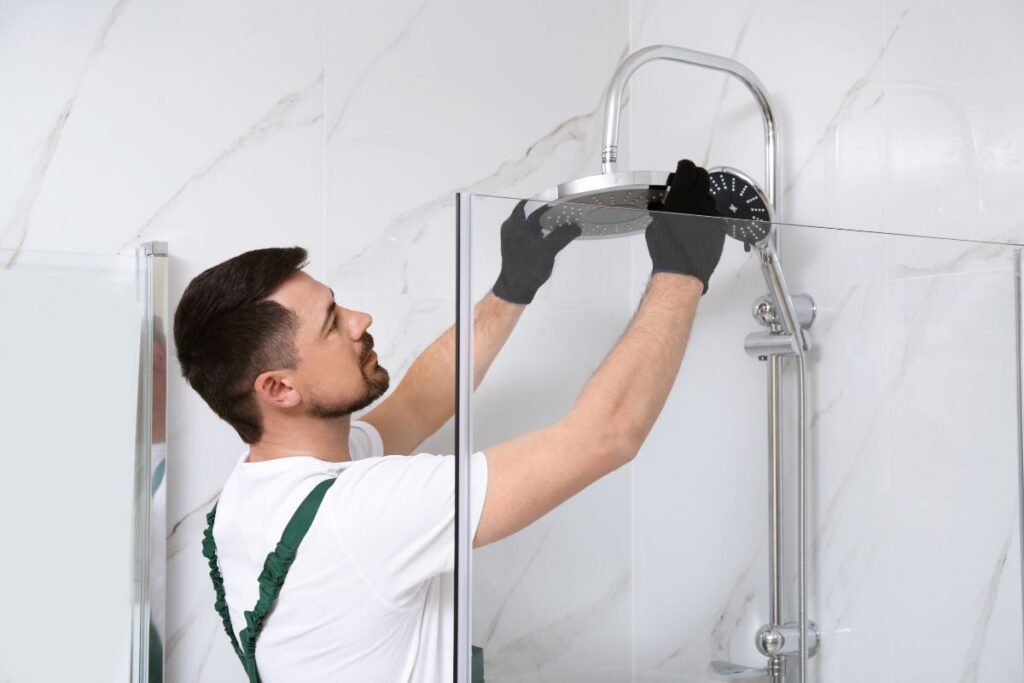
While it might be tempting to DIY a shower remodel, this type of project is best left to the pros. Here’s why hiring a contractor is a smart move:
Skills
Professional contractors have the skills to take on complex tasks like plumbing, waterproofing, and tile installation—all critical aspects of a functional and durable shower. Mistakes in these areas can lead to costly repairs making it worth investing in someone who gets it right the first time.
Time-saving
Remodeling a shower involves multiple steps from demo to plumbing and tile installation. Professionals streamline the process, completing the work faster and more efficiently than most DIYers, reducing delays and making the project progress faster.
Warranty
Hiring a pro gives you peace of mind through warranties. Contractors typically warranty their work so if issues arise they’ll fix them for free. This added security protects your investment and prevents unexpected expenses.
At Rothrock Kitchen & Bath Remodeling we specialize in creating custom showers that fit your style and needs. From design to installation, our team will guide you every step of the way so your remodel is seamless and stress-free. Let us bring your dream shower to life with expert craftsmanship and personalized service!
Ready to create your dream shower?
Choosing the right shower is just one step in turning your bathroom into a space you’ll love for years to come. Whether you envision a spa-like retreat with all the bells and whistles or a modern design that maximizes functionality we can bring your vision to life.
At Rothrock Kitchen & Bath Remodeling we pride ourselves on delivering exceptional craftsmanship and personalized service to homeowners in the New Hampshire seacoast and southern Maine. From concept to completion, our experienced team will guide you through every step of the process so your remodel is seamless and stress-free.
Let’s make your dream bathroom a reality! Contact us today to get started on your shower remodel! Your perfect shower awaits!
